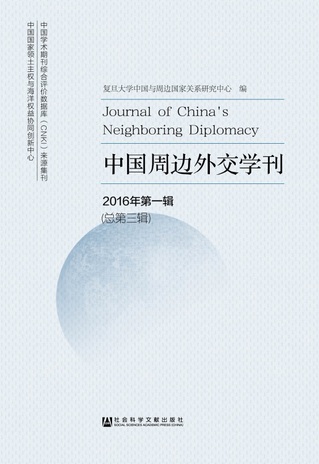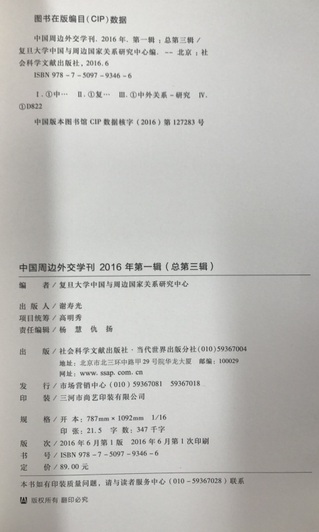The Title Page of Journal of China’s Neighboring Diplomacy, Vol. 2, Issue 1, 2016 |
The Copyright Page of Journal of China’s Neighboring Diplomacy, Vol. 2, Issue 1, 2016 |
Center for China’s Relations with Neighboring Countries of Fudan University (CCRNC-Fudan), ed., Journal of China’s Neighboring Diplomacy, Vol. 2, Issue 1, 2016.
Publisher: Social Sciences Academic Press (China)
Published in June 2016.
ISBN: 978-7-5097-9346-6
Contents
Preface SHI Yuanhua/1
Comprehensive Studies on China’s Neighboring Diplomacy
An Evaluation Report on the Security Situations in China’s Periphery (2015-2016) Zhang Yunling, Ren Jingjing/9
New Historical Developments of China’s Neighboring Diplomacy since CCP’s 18th National Congress Shi Yuanhua/25
“The Belt and Road” Research
South Asia’s View on China’s “the Belt and Road” Initiative Md. Muhibbur Rahman/63
Regional Responses to the Maritime Silk Road Initiative: The Imperatives of Economics, Domestic Concerns and Geopolitical Calculations Kheng Swe Lim and Mingjiang Li/79
Political Risks along “the Belt and Road”: A Comprehensive Study of the Myitsone Dam Project in Myanmar and the Colombo Port City Project in Sri Lanka Jiang Tianjiao/94
Studies on China’s Neighboring Areas
China’s FTA Strategy against the Background of TPP and RCEP He Ping, Qian Yaping/111
ASEAN-China Maritime Cooperation: Maintaining Maritime Security and Regional Stability Angel Damayanti/130
The Chaos in West Asia and China’s Adjustments on Its Policy toward this Region Guo Rui, Fan Congwei/142
China’s Relations with Specific Neighboring Countries
Issues and Transcendence in the China-India Relations Zhang Jiadong/163
Domestic Conditions of China’s Neighboring Countries
A Study of DPRK’s Endogenous Power and Exogenous Variables of Economic Growth Zhang Huizhi/181
Republic of Korea’s Diplomacy toward the Pacific Island Countries Sun Xueyan/198
Hot Spots of the Disputes in South China Seas
The New Developments of Situations in the South China Sea and New Mentality for Responding to Such Changes Wei Zongyou/213
“New Strategic Frontiers” Research
The Shaper of the U.S. Global Commons Security Strategy: CNAS’s Strategic Report of Contested Commons Han Changshun/237
A Perspective on the Framework Design of China’s Outer Space Defense Strategy Jiang Jianzhong/255
Analysis of Abe Cabinet’s Space Strategy and Space Diplomacy: an Interpretation of Abe Cabinet’s two Basic Plans on Space Policy Bao Xiaqin, Yang Yuqing/269
Reviews on Symposiums
A Review on the Symposium of “China-ASEAN Relations and the Construction of Maritime Silk Road” Zhang Qun/287
A Review on the Symposium of “Assessments and Prospects on China’s Neighboring Diplomacy in 2015” Zhang Chi/297
A Review on the Symposium of “Orders of Global Commons and China’s Responsive Strategies” Nan Zhensheng/308
A Review on the Symposium of “Cultural Contacts and Recognition of Identities: the Trends of Ethnic Relations in the Northeast Asia” Mao Yinghui/317
Appendix
Introduction on the Collaborative Innovation Center for Territorial Sovereignty and Maritime Rights (CICTSMR) /325
Introduction on Center for China’s Relations with Neighboring Countries (CCRNC) /327
Notice Inviting Contributions to the Journal of China’s Neighboring Diplomacy /329
An Evaluation Report on the Security Situations in China’s Periphery (2015-2016)
Zhang Yunling, Ren Jingjing
Abstract:The security situation in China’s periphery during the year 2015 can be summarized into one sentence:The gaming between big powers became more intensive,but the overall power structure was stable,with the issues of hot spots were more outstanding but still controllable. In the shaping of China’s peripheral security environment,the construction for a new type of major power relationship was placed on a very important position and regarded as a key link for China to implement a strategy of creating an innovative stability and taking pioneering initiatives. Of all the changes of security situation around China,the issues related to South China Sea became even more tense,the probability of conflicts in the Korean Peninsula was increased,and the risks in the Diaoyu Islands and East China Sea were still existing. The year 2016 will be an eventful year because the tensions of some confrontational hot spots will continue and the chain effects of big powers’ gaming will be spread. The most important missions for China to safeguard its peripheral security are to manage and control disagreements properly,maintain an overall stability in its neighboring countries,and avoid an impact to the whole situation brought by some local or partial disruptions,so that a macro environment for peaceful development can be preserved and sustained.
Author:Zhang Yunling,Research Professor,Member of the Academic Board of the Chinese Academy of Social Sciences(CASS),Dean of the Section of International Studies of the board,and Director of the Center for Regional Security Studies of CASS。Ren Jingjing,Ph.D,Associate Research Professor with the Institute of Contemporary China Studies,and deputy secretary-general of the Center for Regional Security Studies of CASS.
Official citation:Zhang Yunling, Ren Jingjing, “An Evaluation Report on the Security Situations in China’s Periphery (2015-2016)”, Journal of China’s Neighboring Diplomacy, Vol. 2, Issue 1, 2016, pp. 9-24.
New Historical Developments of China’s Neighboring Diplomacy since CCP’s 18th National Congress
Shi Yuanhua
Abstract:Since the 18 National Congress of Chinese Communist Party,the diplomacy towards China neighboring countries has been gradually uplifted to the status of “the Priority of All Priorities”. The historical new developments of China’s neighboring diplomacy are embodied in the four major strategic measures:an initiative for constructing a community of common destiny,a new grand plan outlining “the Belt and Road”,an effort to establish a “New Asian Security Concept”,and a leadership in building the “Asia Infrastructure Investment Bank”. Also,a new path for China’s neighboring diplomacy has been pioneered,which includes the proposal of a core idea of “cooperative win-win pattern”,the practice to try a “compatible coexistence” of the parallel security systems led by China and U.S. respectively,a work to construct a new type of big power relations with Russia,India,and Japan,an effort to promote a fresh “good neighbor diplomacy” with new characteristics,a “bottom-line mentality” to guarantee China’s peaceful development,and an overall coordination of six major new diplomatic paths that include “six big tectonics” and “the binary of Indian Ocean and Pacific Ocean”. At the same time,new themes for China’s neighboring diplomacy in the future have been clarified,including the following six major new themes:a construction for peripheral big power diplomacy with Chinese characteristics,a top-level design for “Grand Neighboring Diplomacy”,an effort to clarify the strategic positioning of disputed issues and disputing neighboring countries,a macro arrangement and strategy emphasizing the land-sea coordination and sea-sea coordination,and an endeavor to carry forward the project of training talents for China’s neighboring diplomacy. A research on the new strategies,new paths,and new themes for China’s neighboring diplomacy since CCP’s 18 National Congress is very important for people to understand the overall arrangement of China’s diplomacy and the future trends of its neighboring diplomacy.
Author:Shi Yuanhua,Professor,Director of the Center for China’s Relations with Neighboring Countries at Fudan University,Deputy Director of the China’s Collaborative Innovation Center for Territorial Sovereignty and Maritime Rights(CICTSMR).
Official citation:Shi Yuanhua, “New Historical Developments of China’s Neighboring Diplomacy since CCP’s 18th National Congress”, Journal of China’s Neighboring Diplomacy, Vol. 2, Issue 1, 2016, pp. 25-59.
South Asia’s View on China’s “the Belt and Road” Initiative
Md. Muhibbur Rahman
Abstract:This paper briefly examines South Asia’s view on the China’s “the Belt and Road” initiative. More precisely,it focuses on responses of India,Bangladesh and Sri Lanka to the 21st Century Maritime Silk Road(MSR)initiative of China. The initiative has generated tremendous prospect for South Asia,a region having deeper ties and exchanges with China both historically and in the contemporary time. While there is a general acceptance of the idea of MSR as a channel for maritime connectivity,countries are facing diplomatic and political dilemmas in making concrete decisions. Economic interdependence and need for infrastructure development,as well as seaward reorientation of national economies have created ample complementarities between China and South Asia. On the other hand,geographic and diplomatic compulsions as small states and lack of domestic political consensus made it difficult for many countries in the region to respond effectively to the call of China. In particular,Bangladesh and Sri Lanka have been struggling to find a pragmatic and balanced way to integrate with Silk Road initiatives. Nevertheless,India is still skeptical about China’s long term motive and has taken rather an ambivalent position with regard to MSR. Geopolitical apprehensions concerning China’s rise and the fear of China’s growing influence in the Indian Ocean made MSR an uneasy development for India,despite the initiative’s potential to accord the country significant economic benefits.
Author:Md.Muhibbur Rahman,Research Officer at Bangladesh Institute of International and strategic Studies(BIISS). From January-April,2015,he worked as Visiting Fellow at the Institute of International Studies(IIS),Fudan University under Fudan Fellowship for Overseas Scholars Program.
Official Citation:Md.Muhibbur Rahman, “South Asia’s View on China’s “the Belt and Road” Initiative”, Journal of China’s Neighboring Diplomacy, Vol. 2, Issue 1, 2016, pp. 63-78.
Regional Responses to the Maritime Silk Road Initiative: The Imperatives of Economics, Domestic Concerns and Geopolitical Calculations
Kheng Swe Lim and Mingjiang Li
Abstract:The 21 Century Maritime Silk Road initiative(MSR)has attracted a lot of attention from foreign governments and research communities. China has exhibited a tremendous amount of enthusiasm for the implementation of the initiative. While Beijing is prepared to provide abundant resources for the initiative,regional countries’ attitudes and responses are equally important for the success or failure of the initiative. This paper identifies three major factors that will help influence the reactions of regional states in Southeast Asia and South Asia to China’s initiative,including the perceived economic benefits from participation in the plan,domestic politics of these states,and the geopolitical calculations of these regional countries. Different countries give different weight to these three factors. As a result,countries in the two regions display different reactions to the MSR. Some are very positive. Some countries are positive but harbors certain reservations. And other countries are passive,if not against,the MSR initiative. It would be wise for Beijing to fully understand the complexities of regional states’ views of the initiative and adopt flexbile policies in order to ensure a fairly smooth implementation of the MSR initiative.
Author:Kheng Swe Lim is research analyst at the S. Rajaratnam School of International Studies,Nanyang Technological University。Mingjiang Li is associate professor at the S. Rajaratnam School of International Studies,Nanyang Technological University.
Official Citation:Kheng Swe Lim and Mingjiang Li, “Regional Responses to the Maritime Silk Road Initiative: The Imperatives of Economics, Domestic Concerns and Geopolitical Calculations”, Journal of China’s Neighboring Diplomacy, Vol. 2, Issue 1, 2016, pp. 79-93.
Political Risks along “the Belt and Road”: A Comprehensive Study of the Myitsone Dam Project in Myanmar and the Colombo Port City Project in Sri Lanka
Jiang Tianjiao
Abstract:With the advance of “the Belt and Road” initiative,more and more Chinese enterprises are entering the developing countries and regions that are underdeveloped in economy and unstable in political and social spheres. Although factors like the rivalry of great powers and the balancing diplomacy and democratic transitions of small countries lead to an increasingly complex business environment for Chinese enterprises,we can still find from a comparative study of the Myitsone dam project in Myanmar and the Colombo port city project in Sri Lanka that uneven profit distributions during Chinese enterprises’ investment in host countries are the main cause of political risks. We suggest that Chinese enterprises shall substantiate the idea of mutually-beneficial development for a cooperative win-win pattern,carry out the investment mode of diversification and profit sharing,and set up independent risk assessment and pre-warning mechanism as soon as possible.
Author: Jiang Tianjiao,Ph.D,Candidate of the School of Internationals and Public Affairs of Fudan University,Research Assistant of the Center for BRICS and Newly Emerging Economies of the Development Research Institute at Fudan University.
Official Citation:Jiang Tianjiao, “Political Risks along ‘the Belt and Road’: A Comprehensive Study of the Myitsone Dam Project in Myanmar and the Colombo Port City Project in Sri Lanka”, Journal of China’s Neighboring Diplomacy, Vol. 2, Issue 1, 2016, pp. 94-107.
China’s FTA Strategy against the Background of TPP and RCEP
He Ping, Qian Yaping
Abstract:In recent years,the regional integration in Asia-Pacific has been presenting a new development trend. While the number of bilateral FTAs keeps growing,the pluri-lateral and regional “Super FTAs” represented by the TPP and RCEP begin to take shape and accelerate. Against this background,China has greatly speeded up its FTA construction,with the ever expanding geographical coverage of FTA partners,extending FTA sectors and issues,and a preliminary strategic framework. The Pilot Free Trade Zones have also prepared China for its participation in negotiations for higher economic and trade standards. Based on this,China should upgrade its FTA level to complete the missing piece and achieve a suitable and adjustable degree of market opening;make the FTAs compatible with the expanding and deepening global value chain and production network from a long-term perspective;anticipate and prepare for the potential expansion of TPP;and strengthen its FTAs with its neighboring countries and developing partners.
Author:He Ping,associate professor at the Institute of International Studies,Fudan University. Qian Yaping,Ph.D,candidate at the School of International Relations and Public Affairs,Fudan University.
Official Citation:He Ping, Qian Yaping, “China’s FTA Strategy against the Background of TPP and RCEP”, Journal of China’s Neighboring Diplomacy, Vol. 2, Issue 1, 2016, pp. 111-129.
ASEAN-China Maritime Cooperation: Maintaining Maritime Security and Regional Stability
Angel Damayanti
Abstract:Globalization depends on the free flow of sea-based shipping. International shipping underpins the prospect of further beneficial growth in world trade,particularly in Asia Pacific region. This provides both an opportunity and a challenge since sea-based globalization is vulnerable to disruption. Therefore,the international shipping needs to be stable and secure. For this reason,some major powers in Asia Pacific such as the US,China and Indonesia have launched their respective strategy in securing maritime in the region. This paper mainly seeks the common concerns between Asia Pacific governments and the role of ASEAN in promoting the maritime cooperation. Their common concerns most likely derive from challenges and threats that come from the sea and at the sea due to lack of maritime security and governance ashore,such as those happened in the South China Sea and Straits of Malacca. Accordingly,this paper proposes an inclusive and comprehensive collaboration between ASEAN member states and China,involving other major powers in Asia Pacific for the maintenance of good order at sea. This maritime partnership is vital for securing the economic development and prosperity as well as maintaining peace and stability in the region.
Author:Angel Damayanti,Lecturer and Senior Researcher at Center for Security and Foreign Affairs Studies(CESFAS)at International Relations Program,Faculty of Social and Political Sciences,Christian University of Indonesia(UKI),Jakarta.
Official Citation: Angel Damayanti, “ASEAN-China Maritime Cooperation: Maintaining Maritime Security and Regional Stability”, Journal of China’s Neighboring Diplomacy, Vol. 2, Issue 1, 2016, pp. 130-141.
The Chaos in West Asia and China’s Adjustments on Its Policy toward this Region
Guo Rui, Fan Congwei
Abstract:In 2015,the highly risky situations of disruptive turbulences and upheavals continued in the West Asia region and there was a very urgent need to establish a clear security order in that region. The current trends of the chaotic situations in this region are characterized by an all-directional,multilayered,and disorderly new normal,which shows that the geographical political game in the area is more violent and complicated. The United States gradually lost its dominant power in West Asia,and there was an obvious decline in its influence and its capacity to control the momentum. Because of the new changes and new features in West Asia,China has made a series of new adjustments on its diplomacy in West Asia,with many attractive new measures. Particularly,its interventions in the settlement of regional hotspot issues,its cooperation in combating international terrorism,and its accelerated pace to construct “the Belt and Road” deserve much attention. China should take the initiative to participate in the construction of the Western Asian regional order,and make proper coordination on the trilateral relations between China,U.S.,and the West Asia,so as to forge the West Asia into a new shaft and a new fulcrum on which China can build new types of relations with its neighboring countries.
Author:Guo Rui,Professor,Doctoral Tutor,Department of International Politics,College of Public Administration,Jilin University,Ph.D of Law,Post-doctor of Theoretical Economics.Fan Congwei,Postgraduate for Master’s Degree,Department of International Politics,College of Public Administration,Jilin University.
Official Citation:Guo Rui, Fan Congwei, “The Chaos in West Asia and China’s Adjustments on Its Policy toward this Region”, Journal of China’s Neighboring Diplomacy, Vol. 2, Issue 1, 2016, pp. 142-160.
Issues and Transcendence in the China-India Relations
Zhang Jiadong
Abstract:The factors on China-India relationship can be divided into two types:structural and non-structural. The structural factors include territorial disputes,China-Pakistan special relationship,water disputes,and competition on international status. Non-structural factors include trade imbalance,visa issue,historical perceptions and cognitions,and differences of strategic priorities. All of these factors are so diversifying and changing that its impacts on China-India relations are in flux. To have a stable and better relationship,China and India must manage structural factors and promote cooperation on non-structural areas simultaneously. To shape a new model of major power relationship,both countries need to soften,weaken,and trivialize traditional obstacles between two countries through a search for new cooperation areas and space.
Author: Zhang Jiadong,Professor of International Relations at Center for American Studies,Vice Director of Center for South Asian Studies,Fudan University.
Official Citation:Zhang Jiadong, “Issues and Transcendence in the China-India Relations”, Journal of China’s Neighboring Diplomacy, Vol. 2, Issue 1, 2016, pp. 163-178.
A Study of DPRK’s Endogenous Power and Exogenous Variables of Economic Growth
Zhang Huizhi
Abstract: In recent years,although DPRK was surrounded by increasingly stringent international sanctions,it still achieved positive economic growth. In the meantime,Pyongyang appears to be in a thriving development. Taking a view on the source of DPRK’s economic growth momentum,we find out that DPRK’s endogenous power for economic growth are embodied in several aspects. First,“DPRK-Style economic management approach” improved labor productivity. Second,the markets for both capital goods and consumer goods were expanded,thus promoting the commercial development and uplifting the domestic demand. Third,increased attention and more investment in science and technology promoted the DPRK’s technological progress. However,due to the harsh environment of trade and investment,for the DPRK,the international trade and foreign investment are only the exogenous variables in economic growth. In view of the vulnerability of DPRK’s industrial structure and long-term technical problems such as inadequate inputs,the DPRK has no choice but to convert the exogenous variables such as trade and foreign investment into endogenous power,through an strengthening of trade openness and an increase of investment. Only in this way will the technological spillover effect be brought into full play in DPRK and the long-term sustainable economic development be truly achieved.
Author:Zhang Huizhi,professor of the Northeast Asian Studies College,Jilin University.
Official citation:Zhang Huizhi, “A Study of DPRK’s Endogenous Power and Exogenous Variables of Economic Growth”, Journal of China’s Neighboring Diplomacy, Vol. 2, Issue 1, 2016, pp. 181-197.
Republic of Korea’s Diplomacy toward the Pacific Island Countries
Sun Xueyan
Abstract:Republic of Korea’s Diplomacy has reached beyond the Northeast Asia and shown the tendency of diversification with a further increase of its synthesizing national power since the end of the Cold War. ROK has expanded its diplomatic targets to the Pacific Island Countries in recent years. In history,Korean Labors were forced to enter the Pacific Island Countries. And ROK has been playing an influential role in the South Pacific as an emerging power located outside this region,by means of ODA and multi-lateral,environmental and cultural diplomacy. ROK-PICs’ friendly relations and cooperation have developed steadily in politics,culture,economy and security. However,the standard and model of their cooperation need to be improved,and the contents and levels of their cooperation have yet to be fully improved or broadened.
Author:Sun Xueyan,Associate Professor of Research Center for the Pacific Island Countries,Liaocheng University.
Official Citation:Sun Xueyan, “Republic of Korea’s Diplomacy toward the Pacific Island Countries”, Journal of China’s Neighboring Diplomacy, Vol. 2, Issue 1, 2016, pp. 198-210.
The New Developments of Situations in the South China Sea and New Mentality for Responding to Such Changes
Wei Zongyou
Abstract:In October 2015,the South China Sea Arbitration Tribunal in Hague announced it had the jurisdiction to consider the Philippines’ case concerning the South China Sea disputes. In the same month,the U.S. destroyer USS Lassen navigated for the first time within 12 miles of the Subi Reef which is claimed by China and where China has been conducting land reclamation. These two developments highlighted the thorny issue of growing South China Sea disputes among China,Taiwan,Vietnam,the Philippines,Malaysia,Indonesia,and Brunei on the one hand,and the rising maritime competition between China and U.S. on the other hand. These developments also posed increasing challenges to China’s maritime claim in South China Sea and maritime aspiration. How China copes with these challenges is an issue of strategic significance and with great implications to China’s maritime aspiration and grand strategy in the long run.
Author:Wei Zongyou,Professor and Ph.D,Tutor of the Center for American Studies,and Part Time Researcher of the Center for Taiwan Studies at the Fudan University.
Official Citation:Wei Zongyou, “The New Developments of Situations in the South China Sea and New Mentality for Responding to Such Changes”, Journal of China’s Neighboring Diplomacy, Vol. 2, Issue 1, 2016, pp. 213-233.
The Shaper of the U.S. Global Commons Security Strategy: CNAS’s Strategic Report of Contested Commons
Han Changshun
Abstract:Based on the conclusion of Barry Posen that command of the global commons is the military foundation of U.S. hegemony,Contested Commons:the Future of American Power in a Multipolar World,the strategic report of CNAS made a comprehensive and detailed analysis to all kinds of challenges that U.S. faces in the global commons,and designed a concrete and highly operable three-dimension strategy for the U.S. to keep its command of the global commons:to lead to build stronger global regimes,to engage responsible pivotal actors,and to reshape American hard power. This report is the result of the debate on American grand strategy for the Post-Cold War Era. Furthermore,this report has both a macro influence on the formulation of the U.S. national security strategy and a micro influence on the implementation of the “re-pivot to Asia” strategy of the U.S. because of the strong governmental backgrounds of the writers and reviewers of this report and the U.S.-style “revolving door” mechanism. Therefore,this report deserves close attentions and meticulous observations from domestic academic and political circles.
Author:Han Changshun,Ph.D,Candidate of School of International Relations and Public affairs of Fudan University.
Official Citation:Han Changshun, “The Shaper of the U.S. Global Commons Security Strategy: CNAS’s Strategic Report of Contested Commons”, Journal of China’s Neighboring Diplomacy, Vol. 2, Issue 1, 2016, pp. 237-254.
A Perspective on the Framework Design of China’s Outer Space Defense Strategy
Jiang Jianzhong
Abstract:Out space has become one of China’s new strategic frontiers. Chinese decision-making institutions also need a systematic and complete strategy for its outer space security and defense. This article focuses on the strategic goal on China’s outer space security and defense,objectively assesses the positive and negative constraints influencing outer space strategic goal,and then proposes an operationally feaible and innovative outer space defense strategy framework in line with China’s outer space development requirement. From the perspective of philosophy,we should construct China’s outer space defense strategy through a philosophical mentality. From the perspective of capacity,China should strengthen and upgrade its outer space defense technology. From the perspective of soft power,Chinese government should uplift its ability to control the institutional discourse power on outer space. From the perspective of national image,China should take the responsibility to build a safer outer space.
Author: Jiang Jianzhong,Ph.D,Lecturer of Nanjing Institute of Politics.
Official Citation:Jiang Jianzhong, “A Perspective on the Framework Design of China’s Outer Space Defense Strategy”, Journal of China’s Neighboring Diplomacy, Vol. 2, Issue 1, 2016, pp. 255-268.
Analysis of Abe Cabinet’s Space Strategy and Space Diplomacy: an Interpretation of Abe Cabinet’s two Basic Plans on Space Policy
Bao Xiaqin, Yang Yuqing
Abstract:January 9, 2015,the ninth meeting of the Strategy Headquarters for Space Policy decided on the new Basic Plan on Space Policy and its roadmap. The new Basic plan on Space Policy comprehensively incorporates the status of the basic plan on space,the new structure to promote the development and utilization of space,as well as the comprehensive and systematical policies and measures that the government should take for the development and utilization of space. It is the first basic plan on space Policy after Abe Cabinet released the Basic Strategy of National Security. Based on the history of Japanese space strategy,this essay aims to analyze the background,motivation and strategic goals indicated in Abe cabinet’s two different basic plans on space policy,and to evaluate the trend of Abe Cabinet’s space policy and its policy of space diplomacy.
Author:Bao Xiaqin,Professor of the Institute of International Studies,Research Fellow of the Collaborative Innovation Center of Territorial Sovereignty and Maritime Rights,Fudan University. Yang Yuqing,Postgraduate of School of International Relations and Public Affairs,Fudan University.
Official Citation:Bao Xiaqin, Yang Yuqing, “Analysis of Abe Cabinet’s Space Strategy and Space Diplomacy: an Interpretation of Abe Cabinet’s two Basic Plans on Space Policy”, Journal of China’s Neighboring Diplomacy, Vol. 2, Issue 1, 2016, pp. 269-284.
Link to the Chinese version: http://www.iis.fudan.edu.cn/9e/8e/c11003a106126/page.htm








